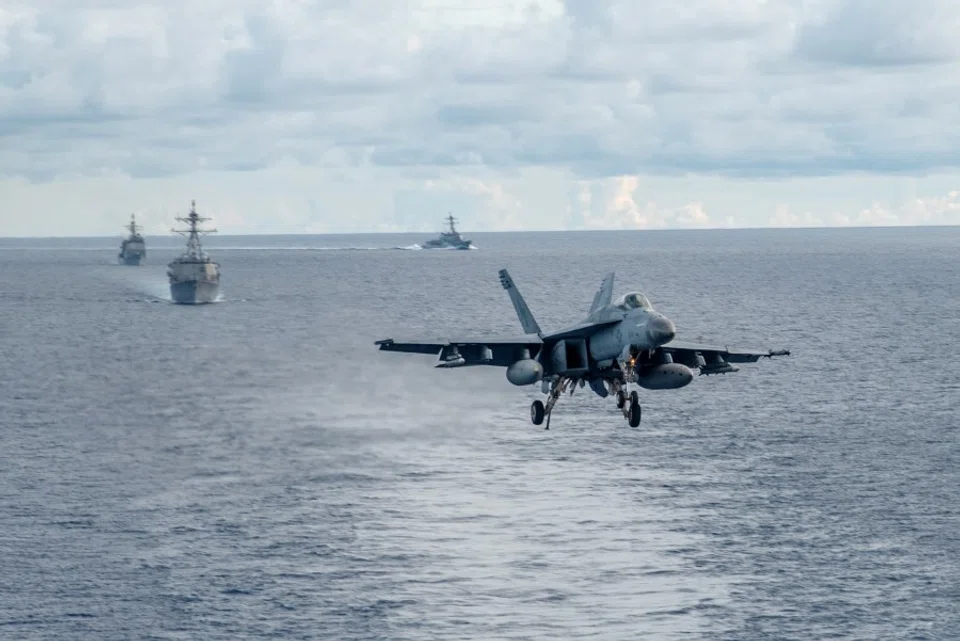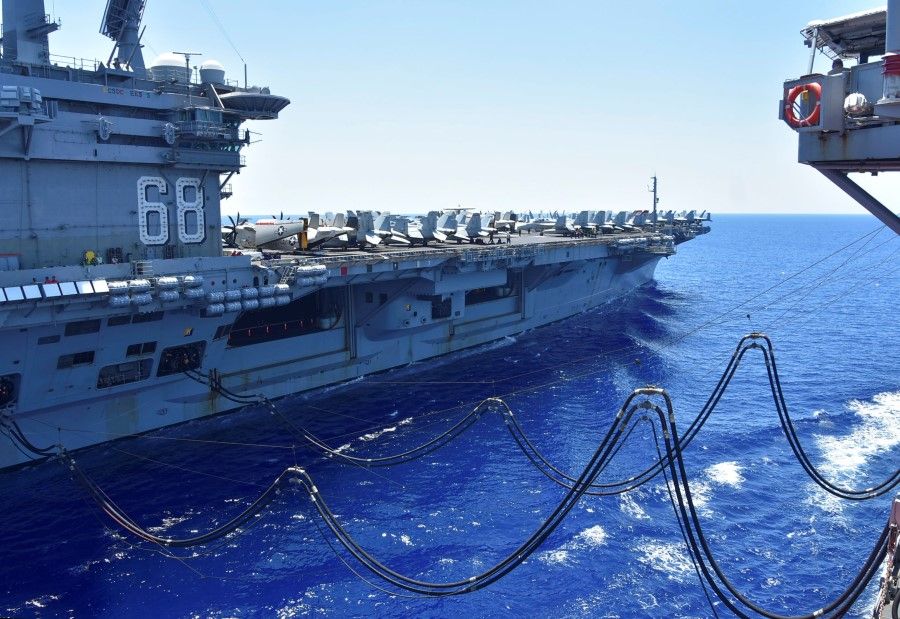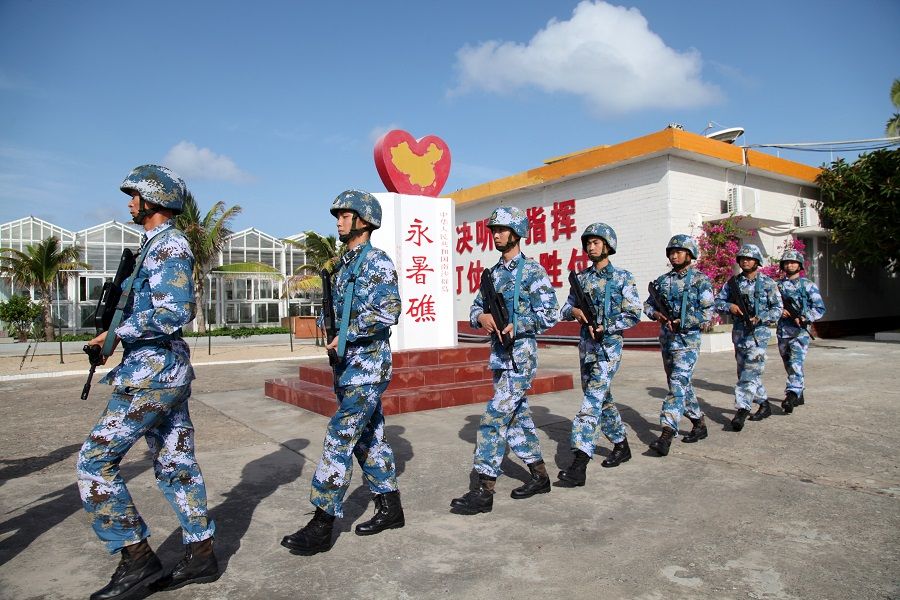Should China station fighter jets in the South China Sea?

As China-US relations continue to deteriorate, China's military academics feel that China-controlled reefs in the South China Sea may be attacked, and China should station fighter jets on its "Big Three" airbases in the Spratly Islands (i.e. Fiery Cross, Subi Reef and Mischief Reef), as standard procedure.
On 23 July, Chinese military academic Wang Yunfei wrote on senstrat.com that right now, it looks very likely that the Trump administration may make an unexpected move and suddenly decide to initiate a military conflict with China in the South China Sea by November. Another Chinese military academic, Chen Hu, also wrote on 24 July that with two US aircraft carriers loitering in the Indo-Pacific, bombers stationed in Guam, and surveillance planes conducting frequent runs around China, the intention of the US is no longer a show of strength through training, but more of preparing for battle.
In July alone... two [US] aircraft carriers carried out two exercises in the South China Sea; before that, the carriers conducted several so-called "freedom-of-navigation operations" in the South China Sea.
Wang wrote that China-US relations are currently on a rapid downward spiral. As marked by the order to close the Chinese consulate in Houston, a new peak in anti-China sentiment in the US has been reached. In particular, the South China Sea is on the brink of a military confrontation - US warships are engaging in frequent threatening actions, and the situation is the closest ever to attacks being launched on China's reefs.

US flexing military muscle in South China Sea
The essay said the US military has been stepping up warship activity in the South China Sea. RC-135, E-8C, P-8A, and RC-12X surveillance planes have been carrying out almost continuous runs in the South China Sea through June and July. Such frequent patrols are on the level of pre-battle strategic technical surveillance. Moreover, B-1B and B-52H bombers have conducted several simulated attacks on China's reefs in the South China Sea. This has probably helped the US form a solid battle plan. In July alone, the two aircraft carriers carried out two exercises in the South China Sea; before that, the carriers conducted several so-called "freedom-of-navigation operations" in the South China Sea. It would not be surprising if the US had long harboured plans to attack China's reefs.
Currently, China-occupied reefs in the Spratly Islands are Mischief Reef, Fiery Cross Reef, Subi Reef, Cuarteron Reef, Johnson South Reef, Gaven Reef, and Hughes Reef. China also controls Scarborough Shoal.
According to Wang, out of all the aforementioned islands, the US military would most likely attack the Scarborough Shoal. Since there are no guards on the island, the diplomatic fallout would be less grave. Alternatively, they could also attack the Mischief Reef, Fiery Cross Reef, and Subi Reef, China's Big Three airbases in the Spratly Islands. Attacking the latter three reefs would deal a major blow to China and garner a lot of international attention. Its political effect in the US would also be significant.
The article added that China should formulate its military plans as soon as possible and normalise the deployment of fighter jets on its Big Three airbases in the Spratly Islands. Deployment of Chinese aircraft carriers in the South China Sea, especially the south central part of the sea, should also be at the top of the agenda.

Wang said that the US may deploy the B-1B and B-52H bombers as they are able to attack and retreat at top speed. Should they attack from the Sulu Sea in central Philippines from east to west, or attack northeast from Malacca, it would be difficult for the Chinese to counter American offences in the air as the Spratly Islands is unguarded by fighter jets. Alternatively, the US could also launch air-to-surface missiles from the USS Hornet, or Tomahawk cruise missiles from warships.
The article added that China should formulate its military plans as soon as possible and normalise the deployment of fighter jets on its Big Three airbases in the Spratly Islands. Deployment of Chinese aircraft carriers in the South China Sea, especially the south central part of the sea, should also be at the top of the agenda. The presence of the Chinese Air Force's land-based fighters along the Bashi Channel deters American bombers from attacking in that direction. If China is also able to deter American bombers from attacking in the south central region of the South China Sea, the overall threat from American bombers can be reduced. At the Paracel Islands, where conditions are even more favourable, the deployment of fighter jets and air defence missile systems should also be normalised.
Chinese military gives rare notification of live-fire drills
Amid rising tensions in the South China Sea, the Chinese military announced that it would be conducting "live-fire target attack drills" to the west of the Leizhou peninsula in the South China Sea from 25 July to 2 August. According to a notice released by the PLA Unit 95180, as this exercise covers a wide area and "powerful ammunition" is expected to be used, fishing activities and maritime transportation will be prohibited to ensure the safety of the local people.
Analysts pointed out that that prohibition notices are generally issued by the maritime department during Chinese military live-fire drills at sea. It is thus very unusual for the notice to be issued by the PLA. This shows that China is also stepping up its war preparations to deal with the worst case scenario.
Related: Chinese military starts 79-day exercises amid pandemic to deter Taiwan and warn the US | The South China Sea: More dangerous and unstable | Visiting Forces Agreement: Uncle Sam still welcome for another year in the Philippines | [South China Sea] Should the Philippines avoid playing the lead role amid rising tensions in SCS? | [South China Sea] Is Malaysia adopting a more confrontational SCS policy?
